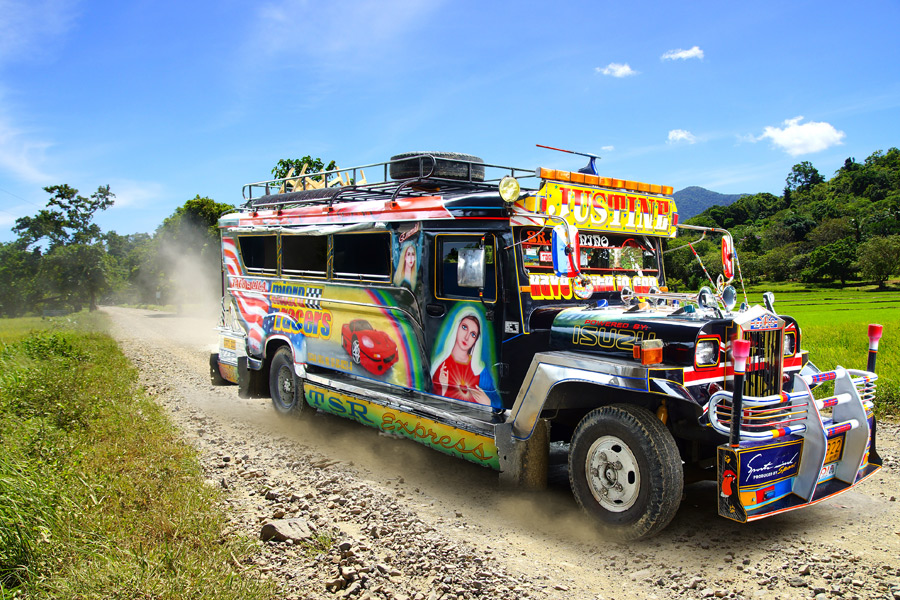[fshow photosetid=72157679399048044]
Although they may seem a little intimidating to the tourist once discovered there is a wealth of local experiences to be found by catching these forms of transport.
Whether weaving in and out of busy Vietnamese traffic on a motorcycle, or bumping along with Filipinos through the back streets and sites of the Philippines, you are guaranteed an unbridled experience of travel authenticity. They are a unique way to get close to the daily feeling of and pace of any city, so hail, flag and negotiate your way around – it’s a great way to travel!
Jump on a Jeepney
The streets of the Philippines are a blaze of colour and guttural engine noises as the most popular form of public transport traverse the cities and towns. Seemingly oblivious to the march of time and modern mass transportation these growling metal beings are the Filipinos go to solution for the cheapest and most effective way of getting around. Welcome to the jeepney! For over half a century they have plied the streets and are fully established as an iconic cultural feature of daily life in the Philippines.
The jeepneys’ attention to decorative detail is a pure projection of Filipino exuberance. Extra lights, stickers, coloured canvasses and polished metal all add to the vibrant melange. Many are adorned with religious symbols, images and dedications reflecting faithful hopes and denomination. These amazing rolling artworks are as individual as human fingerprints and no two of these metallic icons are the same. Serving across the Philippines as a means of livelihood for poor drivers, some are lucky enough to own their jeepney outright while others rent their vehicles.
Jeepneys originated when US forces abandoned thousands of vehicles after WWII and adept local minds reinvented them to serve as a minibus style transport. At some moment in time the jeepney assembly underwent an evolution, introducing a lengthened framework to allow more passengers to squeeze into the narrow rear section. No-one is definitive of the origin of the name jeepney but some thought is that it comes from a combination of ‘jeep’ and ‘knee’ as passengers sitting opposite each other in the crowded narrow body had to sit knee to knee. Recent legislative moves to cut carbon emissions and traffic congestion means that many older classic jeepneys might well be phased out in the coming years. The sheer number of jeepneys on the road, stopping as and when passengers wish to clamber on and off, causes even greater stress on the road systems. However, it is unlikely that they will go without a struggle. So pick a destination and climb aboard these endangered species – Filipinos will be happy to help you – or go ahead and ride around town just for the fun of it!
Motorcycle Hugs in Vietnam
Need a quick way to beat chaotic Vietnamese city traffic? The sure way is to find one of the abundant motorcycle taxis, known as xe om, to run you to your destination. Vietnamese streets are often full to bursting – a kaleidoscope of movement and spectacle. So time to get on and get a ‘motorcycle hug’ – the literal translation of xe om! Don’t worry, you can skip the hug and substitute a smile instead – the riders will just be happy with a fare.
On almost every city street corner you’ll find men and younger lads sitting casually on their motorcycles, or even lying in gravity defying repose. You’ll also find a few intrepid women scouting for work as you seek out a ride. Most xe om riders will sport an intimate knowledge of all the parts of the city and know the quickest way to your destination. Of the transport options at hand a xe om ride beats a sealed taxi ride and gives you that open freedom of riding pillion and the opportunity to feel all the street sensations up close. Check out xe om day tours operating in the cities. These will whisk you about the sights and hidden treasures of the city with a local guide filling you in on the dazzling street life you will pass.
There are a few initial rules to the xe om experience as a visitor to Vietnam. Being clear about your destination is your first step and if you can say the name in Vietnamese, or have it written down by a friend or hotel staff, then that moves things along nicely. Having a street map and knowing the distance you are going to travel also helps with step two – fixing a price. Ask your hotel what the local ‘going’ rate is for xe om so you are aware of the figures you should be paying, then head out and start your negotiation with a driver. Remember that there is an element of fun in finding an agreeable price and that seeking out the lowest base rate isn’t necessarily the final aim! Keeping a cheerful countenance and play-acting will engender some fun and a smiling xe om adversarial bout! Once a price is fixed then drivers will have no reason to trundle around the houses in an effort to convince you of the hardship and difficulties of a trip.
Tips:
- On jeepney trips, remember to carry small change to make paying your fare easier and if you are seated towards the back, pass your money forward via the other passengers. When you are ready to get off say ‘para po’ or ring the bell to signal the driver. You’ll be a jeepney expert in no time at all. For more information on jeepneys, see: http://www.tourisminthephilippines.com/transport/jeepney/philippine-jeepney-info.html
- On xe om tours, keep your bag tucked between you and the driver and some smaller notes handy for paying your fare. Please do make sure that your travel insurance covers trips on a motorcycle and do indicate that there’s no rush. For more information on xe om, see :http://www.xeomtour.com/

